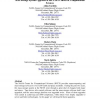SSDBM
1999
IEEE
14 years 7 months ago
1999
IEEE
In many scientific domains, experimental devices or simulation programs generate large volumes of data. The volumes of data may reach hundreds of terabytes and therefore it is imp...
MSS
1999
IEEE
14 years 7 months ago
1999
IEEE
When the BaBar experiment at the Stanford Linear Accelerator Center starts in April 1999, it will generate approximately 200TB/year of data at a rate of 10MB/sec for 10 years. A m...
MSS
2000
IEEE
14 years 7 months ago
2000
IEEE
The NASA Center for Computational Sciences (NCCS) provides supercomputing and mass storage services to over 1200 Earth and space scientists. During the past two years, the mass st...
MSS
2000
IEEE
14 years 7 months ago
2000
IEEE
Many applications, that need mass storage, manipulate data sets with KB – MB size objects. In contrast, mass storage devices work most efficiently for the storage and transfer ...
MSS
2000
IEEE
14 years 7 months ago
2000
IEEE
We describe a real implementation of a software component that manages caching of files from a tertiary storage management system to a large disk cache developed for use in the a...
MSS
2005
IEEE
14 years 8 months ago
2005
IEEE
Fermilab provides a multi-Petabyte scale mass storage system for High Energy Physics (HEP) Experiments and other scientific endeavors. We describe the scalability aspects of the h...
MSS
2005
IEEE
14 years 8 months ago
2005
IEEE
One of the world’s largest scientific data systems, NASA’s Earth Observing System Data and Information System (EOSDIS) has stored over three petabytes of earth science data in...



